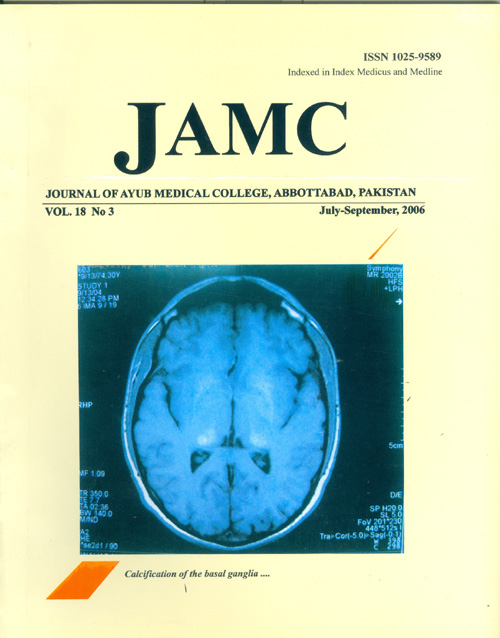CHILBLAINS AT ABBOTTABAD, A MODERATELY COLD WEATHER STATION
Abstract
Background: Chilblains are quite often seen in various parts, in particular cold weather areas ofPakistan. Unfortunately, no studies have so far been carried out in Pakistan, to determineepidemiological aspects of chilblains. The objective of this study was to see the epidemiologicalpatterns of chilblains at a moderately cold weather station. Methods: The study was conducted atDermatology out patient department of Combined Military Hospital, Abbottabad from 1 Dec 2004to 31 Mar 2005. All the patients fulfilling clinical criteria for the diagnosis of chilblains wereregistered. Every patient was interviewed in detail followed by thorough physical examination.Complete Blood Count, Urine Routine Examination and Anti Nuclear Factor were carried out inonly those patients, having the disease of more than 3 years duration. A pre-designed proformawas filled separately for each patient. Results : Out of 111 patients, 67 (60.4%) males and 44(39.6%) females were registered with the diagnosis of chilblains. Fifty nine (53.2%) patients werelocals and 52 (46.8%) were non locals. Out door workers were 75 (67.6%). Onset in majority ofthe patients (42.3%) was in the age group 11-20 years. Family history of chilblains was present in25 (22.5%) patients and 8 patients (7.2%) were smokers. The disease of longer duration was morecommon in females and locals. Conclusion: At moderately cold weather areas, out door workersand young adolescents are more likely to develop Chilblains. The disease of longer duration ismore common among females and local residents. On the other hand, first episode or the diseaseof shorter duration is more common among non locals at moderately cold weather stations becauseof poor acclimatization and inadequate protection.Keywords : Chilblains, perniosis, cold weather injuries.References
Long WB 3rd, Edlich RF, Winters KL, Britt LD. Cold
injuries. J Long Term Eff Med Implants. 2005; 15(1):67-78.
Price RD, Murdoch DR. Perniosis (Chilblains) of thigh:
report of five cases, including four following river crossing.
High Alt Med Biol. 2001; 2(4): 535-8.
Maroon MS, Hensley D. In: Elmets CA, Vinson R, Libow L,
Quirk C, James WD eds. eMedicine World Medical Library,
August 20, 2002.
Carpentier PH. [Definition and epidemiology of vascular
acrosyndromes] [Article in French]. Rev Prat. 1998; 48 (15):
-6.
Yazawa H, Saga K, Omori F, Jimbow K, SasagawaY. The
chilblains-like eruption as a diagnostic clue to the blast crisis
of chronic myelocytic leukemia. J Am Acad Dermatol. 2004;
(2 Suppl): 542-4.
Weston WL, Morelli JG. Childhood pernio and cryoproteins.
Pediatr Dermatol. 2000; 17(2): 97-9.
White KP, Rothe MJ, Milanese A. Perniosis in association
with anorexia nervosa. Pediatr Dermatol. 1994; 11 (1): 1-5.
Viguier M, Pinquier L, Cavelier-Balloy B, de la Salmoniere
P, Cordoliani F, Flageul B, Morel P, Dubertret L, Bachelez
H. Clinical and histopathologic features and immunologic
variables in patients with severe chilblains. A study of the
relationship to lupus erythematosus. Medicine (Baltimore).
; 80(3): 180-8.
Sarteel-Delvoye AM, Wiart T, Durier A. [Chilblains] [Article
in French]. Rev Prat. 1998; 48(15):1673-5.
Langtry JA, Diffey BL. A double-blind study of ultraviolet
phototherapy in the prophylaxis of chilblains. Acta Derm
Venereol. 1989; 69 (4): 320-2.
Moran DS, Heled Y, Shani Y, Epstein Y. Hypothermia and
local cold injuries in combat and non-combat situations—the
Israeli experience. Aviat Space Environ Med. 2003; 74(3):
-4.
Candler WH, Ivey H. Cold weather injuries among U.S.
soldiers in Alaska: a five-year review. Mil Med. 1997;
(12): 788-91.
Rustin MH, Newton JA, Smith NP, Dowd PM. The treatment
of chilblains with nifedipine: the results of a pilot study, a
double-blind placebo-controlled randomized study and a long
term open trial. Br J Dermatol. 1989; 120 (2): 267-75.
Dowd PM. Reactions to cold. In: Burns T, Breathnach SM,
Cox N, Griffith C, Eds. Rook’s Textbook of Dermatology.
Oxford Blackwell Science, 2004: 23.1-23.17.
Spittell JA Jr, Spittell PC. Chronic pernio: another cause of
blue toes. Int Angiol. 1992; 11(1): 46-50
Bilancinis S, Lucchi M, Tucci S. [Acute perniosis, a new
therapeutic option: iontophoresis] [Article in Italian] Minerva
Cadioangiol. 1998; 46(10): 399-400.
Vayssairat M. [Chilblains] [Article in French]. J Mal Vasc.
; 17(3): 229-31.
Issue
Section
License
Journal of Ayub Medical College, Abbottabad is an OPEN ACCESS JOURNAL which means that all content is FREELY available without charge to all users whether registered with the journal or not. The work published by J Ayub Med Coll Abbottabad is licensed and distributed under the creative commons License CC BY ND Attribution-NoDerivs. Material printed in this journal is OPEN to access, and are FREE for use in academic and research work with proper citation. J Ayub Med Coll Abbottabad accepts only original material for publication with the understanding that except for abstracts, no part of the data has been published or will be submitted for publication elsewhere before appearing in J Ayub Med Coll Abbottabad. The Editorial Board of J Ayub Med Coll Abbottabad makes every effort to ensure the accuracy and authenticity of material printed in J Ayub Med Coll Abbottabad. However, conclusions and statements expressed are views of the authors and do not reflect the opinion/policy of J Ayub Med Coll Abbottabad or the Editorial Board.
USERS are allowed to read, download, copy, distribute, print, search, or link to the full texts of the articles, or use them for any other lawful purpose, without asking prior permission from the publisher or the author. This is in accordance with the BOAI definition of open access.
AUTHORS retain the rights of free downloading/unlimited e-print of full text and sharing/disseminating the article without any restriction, by any means including twitter, scholarly collaboration networks such as ResearchGate, Academia.eu, and social media sites such as Twitter, LinkedIn, Google Scholar and any other professional or academic networking site.









